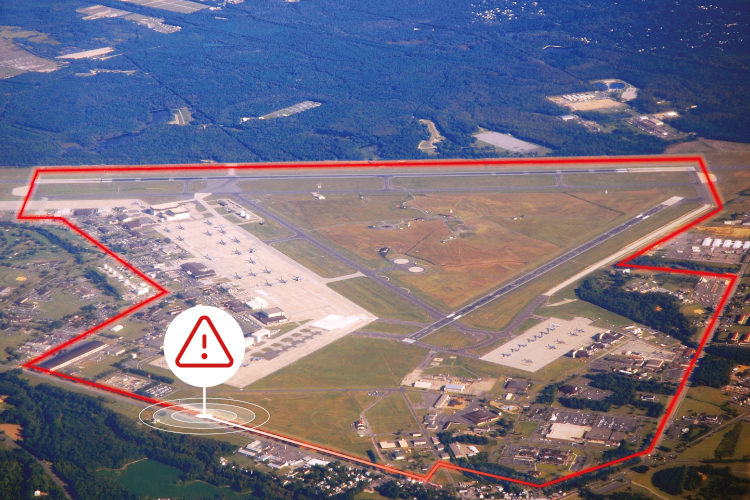Straight to the Point
Advanced sensing technologies provide the ability to locate the exact point of intrusion in real time.

Being able to quickly and accurately locate intrusion is a critical part of any good security system; the sooner an intruder is located, the faster the situation can be verified and the appropriate action taken, minimising disruption. Most security sensors narrow down the location of an intruder by creating detection zones which work in conjunction with camera pre-sets to help security teams visually verify the event and, to a certain extent, track intruders. But in certain applications, being able to know exactly where the point of intrusion is allows a far quicker visual verification process, decreasing the risk of losing the target and increasing the chance of stopping intruders before any damage is done.
What is point location and which technologies offer this level of precise detection?
Point location or point detection technologies enable security staff to know, in real time, exactly where a breach is taking place, which in turn makes the visual verification process significantly quicker as cameras can look precisely to the point where the intruder is, and then track them throughout the protected area.
Several technologies allow point location of an intrusion. One of the most effective is LiDAR, which enable the exact coordinates of intruders to be determined. LiDAR sensors typically work by 'Time of Flight'. When a sensor emits pulsed light waves into the surrounding environment, these pulses bounce off surrounding objects and return to the sensor. The sensor uses the time it took for each pulse to return to the sensor to calculate the distance it travelled. Optex Redscan Pro is an award-winning long-range LiDAR which can be mounted vertically or horizontally to protect large areas pinpointing the X&Y coordinates of the intruder and allowing tracking in real-time.
Some fibre optic sensors can also pinpoint an intrusion to a couple of metres of precision within a several kilometre perimeter. Distributed Acoustic Sensor (DAS) technology, for example, can convert a single mode fibre into thousands of extremely sensitive acoustic and vibration sensors. The most common installation would be on a fence to detect any breach by intruders, either climbing over it or cutting through it, but it can also be buried. One of the latest available solutions, Fiber SenSys EchoPoint series, can pinpoint an intrusion down to +-6 metres, even on a fence that is several kilometres long and can identify different types of breach, whether it is an attempt to climb the fence, cut through it or, when buried, whether its walking or machine digging.
Buried End-to-End Correlation (E2EC) technology is one of the latest developments in point detection. Sensors can be buried next to the perimeter line or in an open area to create an invisible perimeter line consisting of Radio Frequency (RF) energy. The sensors identify vibrations on the ground and alert of approaching persons or vehicles, precisely identifying the location of the object to +/-1m. Buried applications can prevent a breach even before it is attempted and has the benefit of being non-visible for intruders.
Radar technology can also be used to monitor wide open areas and site perimeters; and track multiple objects. Radars send out electromagnetic waves similar to wireless computer networks and mobile phones, in that same way, the pulse reflects off precipitation and sends the signal back to the radar.
Applications which can benefit from point detection
Large premises, such as critical infrastructure sites, can benefit greatly from point location, where the risk of a breach is significantly higher for security reasons or business continuity. Critical assets, such as storage tanks and generators or substations, just beyond the perimeter line are also at risk and it is therefore critical to act quickly to prevent major damage or theft from occurring. Being able to pinpoint exactly where the intrusion takes place will ensure the response team can act immediately.
There are corporate or law-enforcement buildings with the security needs to monitor activity for each opening, such as windows for instance. The ability to use X&Y coordinates to map each opening will provide the required level of precision.
For facilities with a perimeter greater than 5km long or for very large perimeters, such as those that protect a country's border, the precision of point location technology provides the security team with enough information to locate the intrusion and act quickly. It can also send surveillance drones to the area.
Another application is distribution centres, where the constant activity on site could make visual verification more difficult. In these locations, within the perimeter, there are some critical areas. It could be a potential weak point in the perimeter: such as an access gate or turnstile where an intrusion is more likely to be attempted.
The most important step is to assess the security risk and response time. Establishing how quickly an intruder can access a critical area and how quickly can the visual verification of the intrusion be performed will help determine whether a more precise point of location is required. However, point location systems can only deliver their full value if the functionality is integrated with a suitable VMS platform that can interpret the data and present it in a meaningful way to operators.














